While winter gardens often look barren, you can transform yours into a vibrant, year-round spectacle with seasonal plants. Start by mapping out your garden space, allocating 2-3 square feet per plant type for proper growth. Consider bloom times, like tulips for spring or asters for fall, to guarantee constant color. Curious about the exact lineup for each season? Stick around to uncover the perfect planting plan.
Contents
Spring Tulip Planting
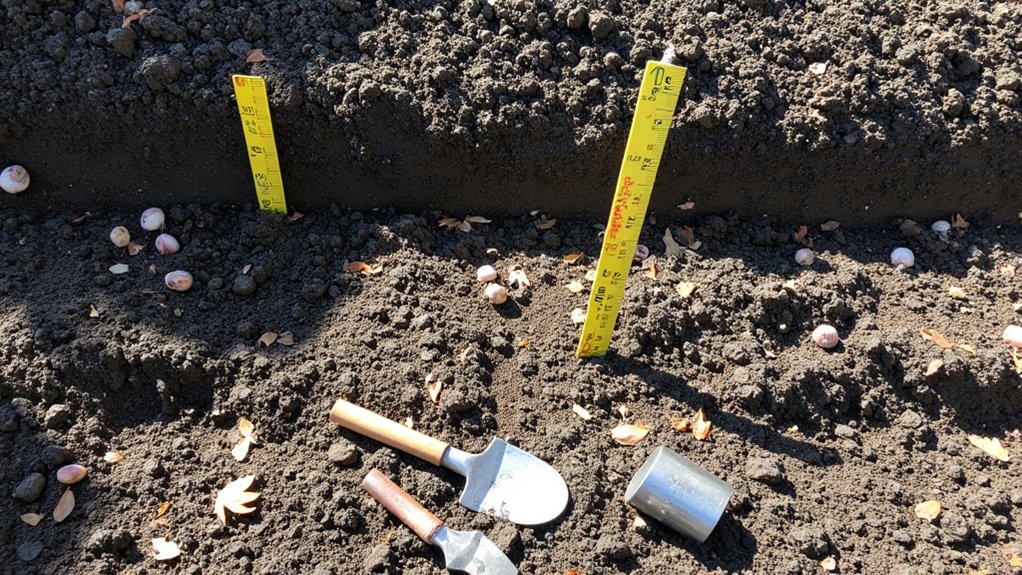
As fall rolls around, it’s the perfect time to start planning your spring tulip display. You’ve gotta act now, since tulip bulbs need planting in autumn. Grab those bulbs early, ideally by mid-October, to guarantee the best selection.
Start by picking a sunny spot with well-draining soil, about 6-8 inches deep for planting. Dig holes twice the bulb’s height, spacing them 4-6 inches apart, pointy end up. Cover with soil, pat it down, and water lightly to settle the dirt. This depth helps protect against frost.
Don’t skimp on quantity—plant at least 20 bulbs for a bold show. Keep the area weed-free, and wait for those vibrant blooms in April or May. You’ll see, it’s worth the prep!
Summer Rose Cultivation

Hey, let’s shift gears from those spring tulips to getting your roses ready for a stunning summer display. Summer’s heat can stress roses, so you’ve gotta act now. Start by pruning dead or weak stems in early June, cutting just above a five-leaflet node.
Next, water deeply, about 1-2 inches per week, especially during dry spells. Do this early in the morning, avoiding wet leaves, which can invite fungal issues. Add a 2-3 inch layer of mulch around the base to retain moisture and keep roots cool.
Finally, fertilize with a balanced 10-10-10 mix every 4-6 weeks until mid-August. Watch for pests like aphids; a quick blast of water usually knocks ‘em off. Keep at it, and your roses’ll shine all summer!
Fall Aster Selection
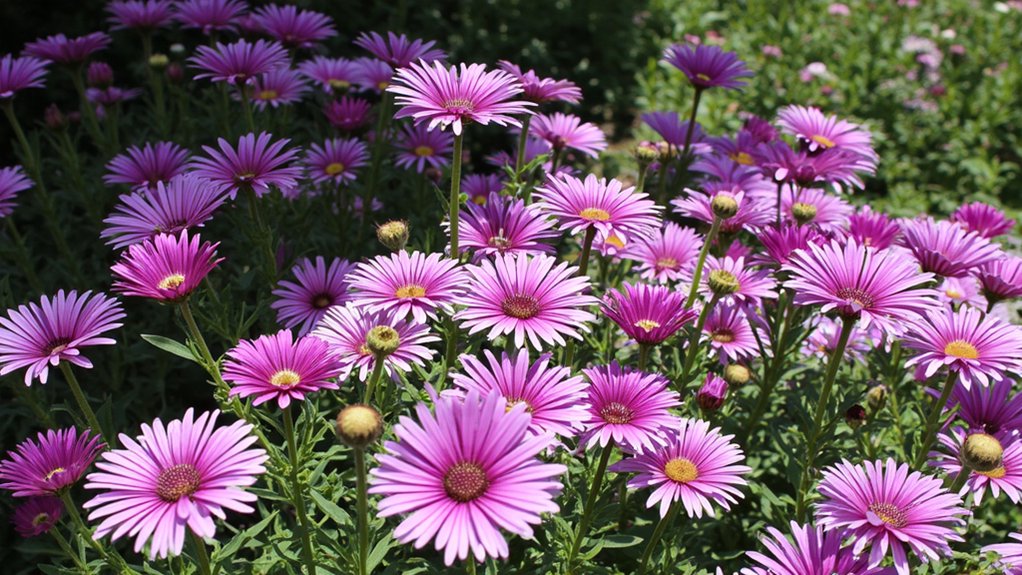
Now that summer’s winding down, let’s plunge into picking the right asters for a vibrant fall garden. These late-blooming perennials, often called Michaelmas daisies, can splash your yard with purple, pink, or white hues. Stick to hardy varieties like New England asters for reliability.
Start by choosing a sunny spot, ideally with 6 hours of direct light daily, and well-drained soil. Plant them in early fall, spacing clumps 18-24 inches apart, to give roots time to settle before frost. Water them twice weekly, about 1 inch per session, until they’re established.
Check for compact varieties, around 2-3 feet tall, if you’ve got limited space. Deadhead spent blooms every few weeks to keep ‘em looking sharp and encourage more flowers.
Winter Holly Arrangement
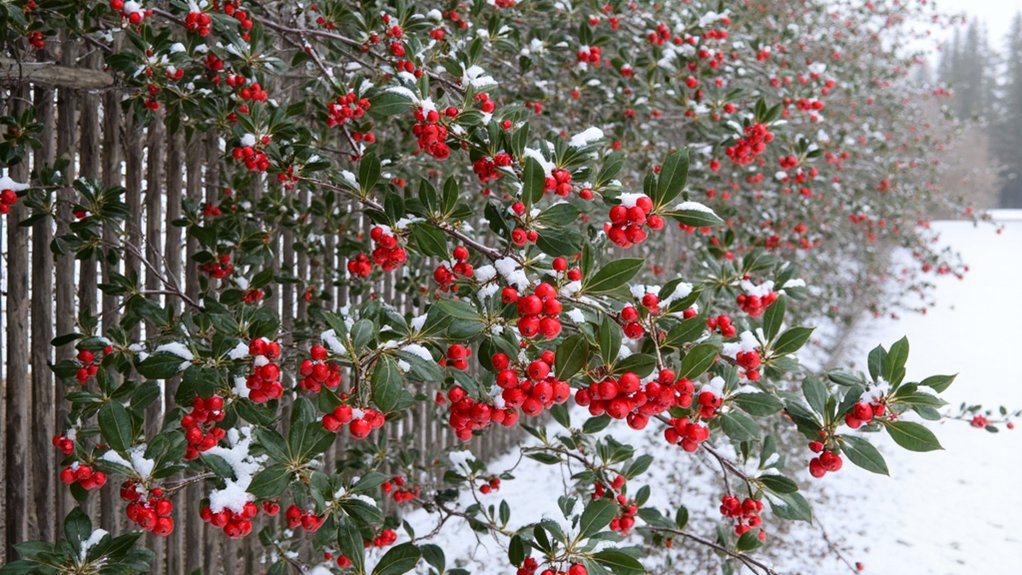
While the chill of winter creeps in, let’s focus on crafting a stunning holly arrangement for your garden. Holly, with its glossy leaves and bright berries, adds a pop of color. You’ve gotta love that contrast against the snow!
Start by selecting a spot, ideally near a fence or wall, for wind protection. Grab a young holly bush, about 2-3 feet tall, from a local nursery. Plant it in well-drained soil, spacing multiple bushes 5 feet apart, to allow growth. Dig a hole twice the root ball’s width, usually 12-18 inches, and mix in compost.
Water deeply after planting, about 1 inch per week, unless it rains. Prune lightly in late winter, shaping it for fullness. There ya go, winter beauty!
Autumn Mum Integration
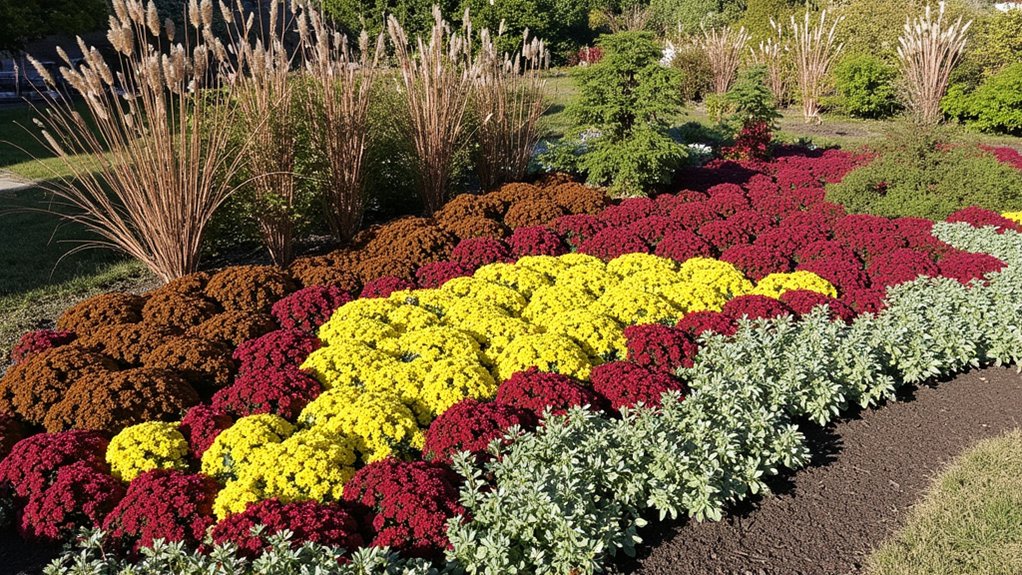
Take a moment to contemplate adding autumn mums, those vibrant chrysanthemums, to your garden for a burst of late-season color. They’re a fantastic pick, blooming from September through November, when most plants fade. You’ll get shades of orange, yellow, and deep red, instantly lifting your garden’s vibe.
Here’s how to start: buy potted mums from a local nursery around early fall. Plant them in well-drained soil, spacing each about 18-24 inches apart, in a spot with full sun, at least 6 hours daily. Dig a hole twice the pot’s width, set the plant in, and cover with soil. Water thoroughly, about 1 inch weekly, to help roots settle.
Keep ‘em thriving by pinching back dead blooms. This trick extends their flowering time, ensuring color till frost hits.
Early Spring Crocus Planting
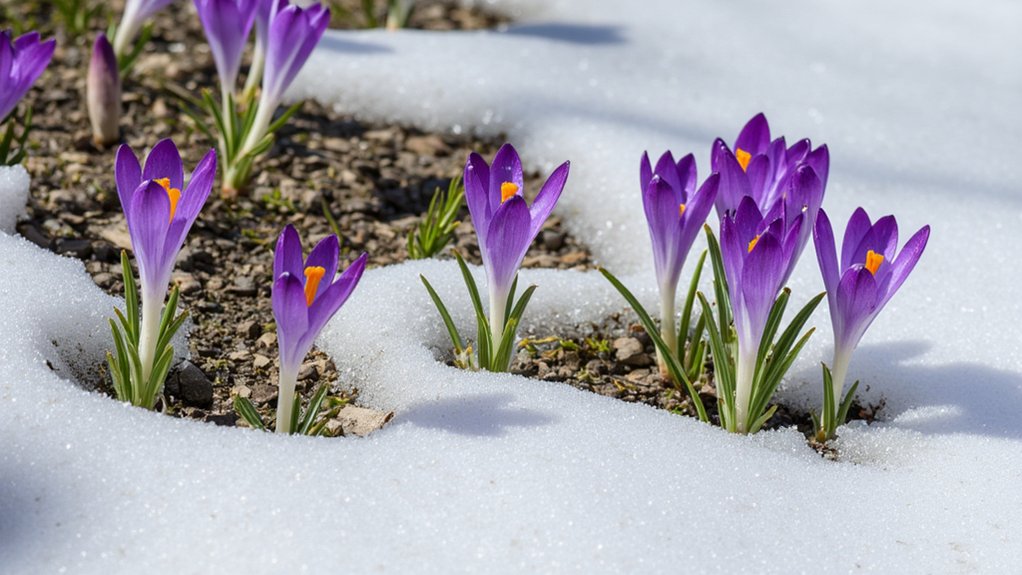
As winter fades, dive right into planting early spring crocuses to kick off your garden’s color show. These little bulbs, often just 3-4 inches tall, pack a punch of purple, yellow, or white. You’ll love seeing them peek through the last snow.
Start by choosing a sunny spot with well-drained soil, ideally in late fall or very early spring. Dig small holes, about 3-5 inches deep, spacing them 2-3 inches apart for a dense look. Drop in the bulbs, pointy end up, then cover with soil.
Water lightly after planting, ensuring the ground stays moist but not soggy. By March or April, expect those first blooms. Keep an eye out, as they signal spring’s arrival with subtle charm.
Late Summer Dahlia Display
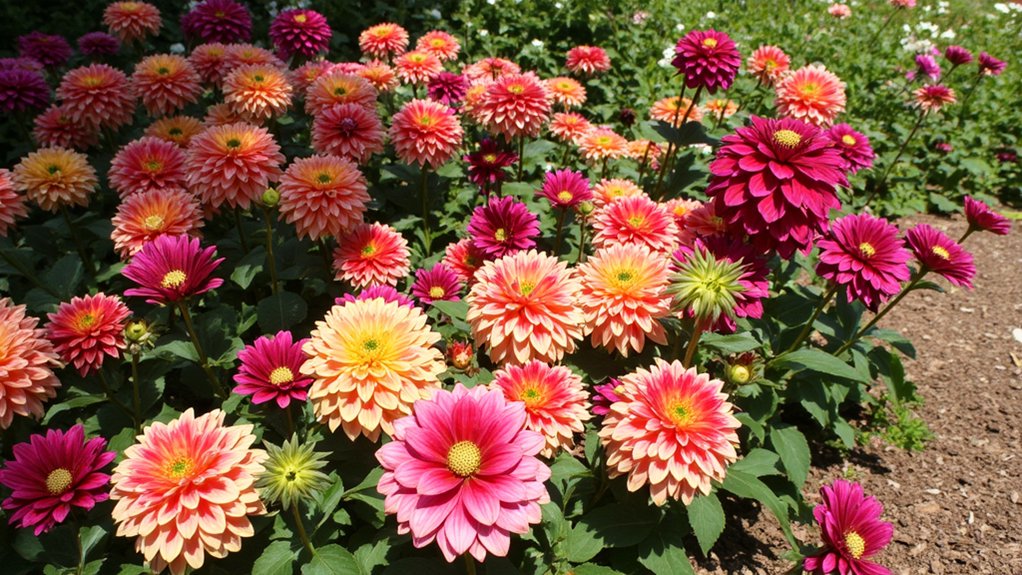
After enjoying your spring blooms, turn your attention to late summer with a stunning dahlia display. You’ve gotta try these vibrant flowers; they’re a game-changer for your garden’s late-season look. Dahlias come in countless colors and sizes, from dinner-plate blooms to petite pompons.
Start by planting tubers in well-drained soil, around mid-spring, about 6 inches deep. Space them 18-24 inches apart, ensuring they get full sun, at least 6 hours daily. Water moderately, keeping soil moist but not soggy, and add a 2-inch mulch layer to retain moisture.
Winter Pansy Selection
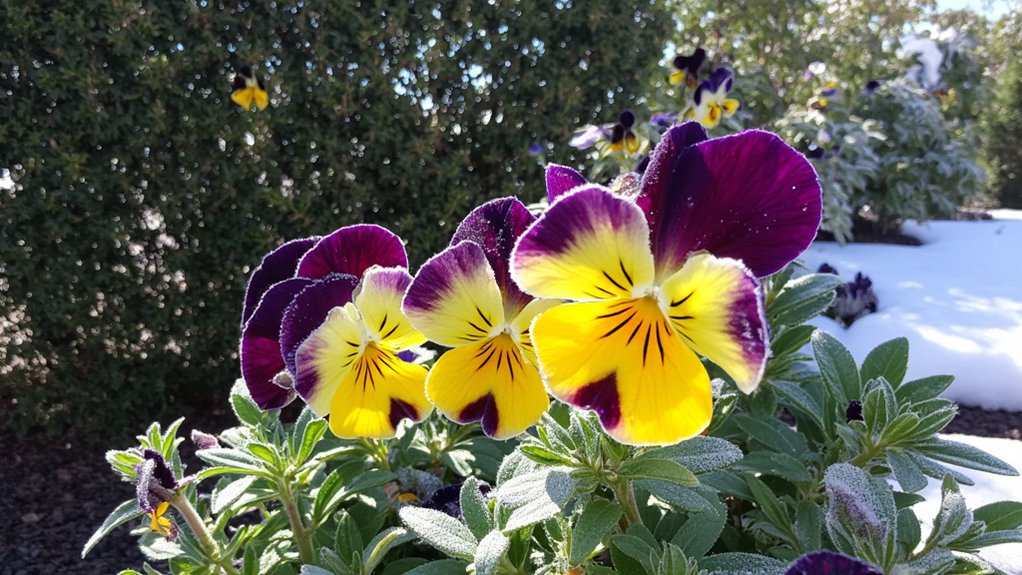
While the late summer blooms fade, let’s shift focus to winter with a vibrant pansy selection. You’ve got a chance to brighten those chilly months, so don’t miss out. Pansies thrive in cold weather, offering bold colors like deep violet, sunny yellow, and crisp white.
Start by picking hardy varieties, such as the ‘Matrix’ or ‘Delta’ series, known for frost resistance. Plant them in well-drained soil, spacing plants 6-8 inches apart, ideally in early fall. This timing, around late September to early October, guarantees roots settle before hard freezes hit.
Water them moderately, about once a week, unless rainfall covers it. Add a 2-inch mulch layer for insulation. You’ll see blooms even in light snow, keeping your garden lively!
Spring Daffodil Showcase
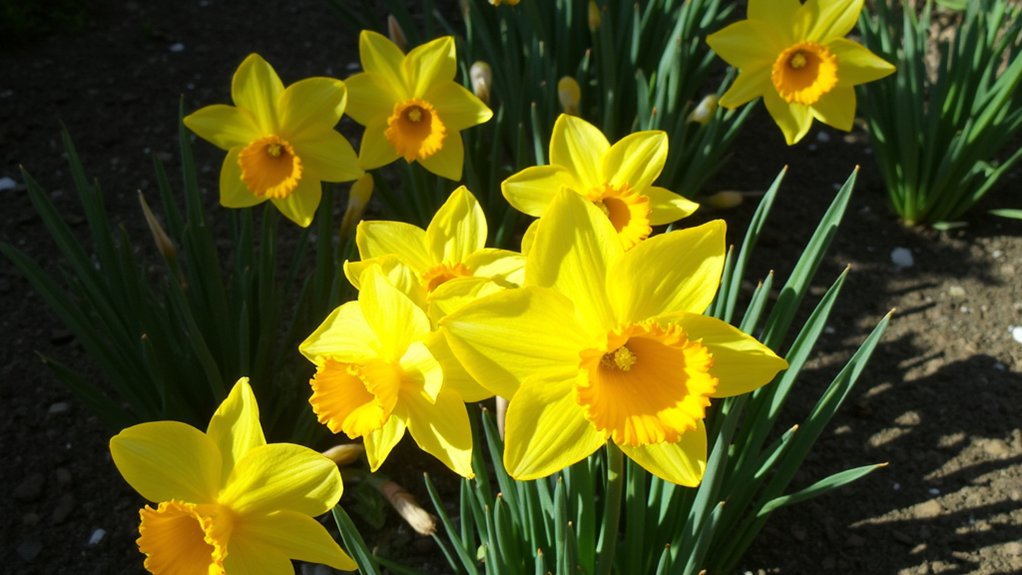
Now that winter’s chill is fading, let’s plunge into planning your spring daffodil showcase for a burst of early color. You’ve got to start now, so grab your gardening gloves and listen up.
First, pick a sunny spot with well-draining soil, ideally 6-8 inches deep for planting. Buy bulbs in late summer or early fall, aiming for varieties like ‘King Alfred’ or ‘Tête-à-Tête’, and plant them 6 inches apart, pointy end up, around mid-October. This timing guarantees they’ll bloom by March or April.
Next, cover them with soil, water lightly, and wait. You’re setting up for vibrant yellows and whites to pop up. Just keep the area weed-free, and don’t cut foliage until it yellows naturally for best results.
Early Fall Marigold Planting
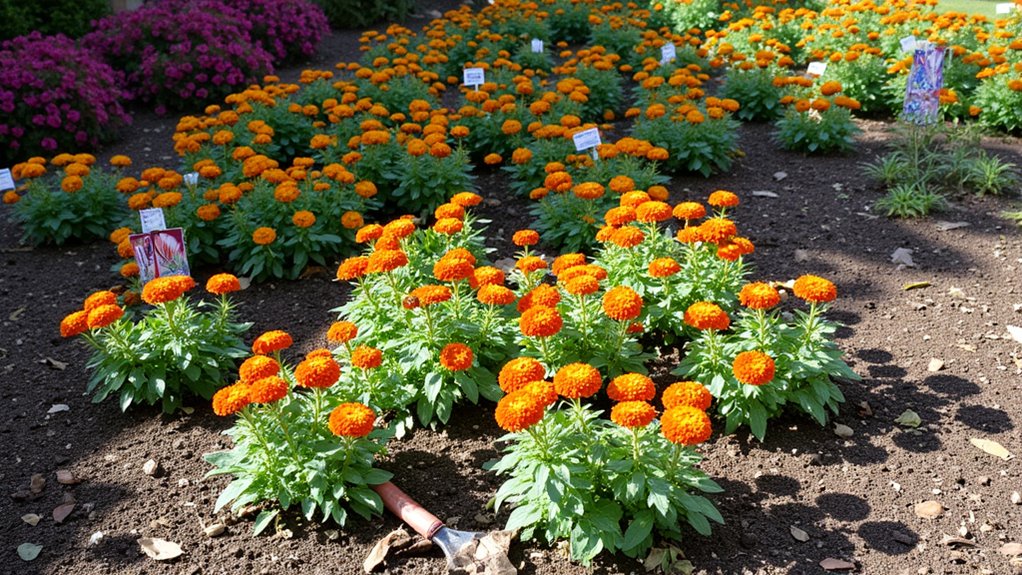
Before the first frost sneaks in, let’s get those marigolds planted for a splash of late-season color. These hardy flowers, with their bright golds and oranges, thrive in early fall. You’ve gotta act fast, though, to enjoy their bloom before winter hits.
Start by choosing a sunny spot, ideally with well-drained soil, and dig holes about 8-10 inches apart. Plant your marigolds, whether seeds or seedlings, at a depth of 1 inch, then cover lightly with soil. Water them gently, ensuring the ground stays moist but not soggy, for the first week.
Check on them every few days, especially around mid-September to early October. With luck, you’ll see buds in 6-8 weeks, adding vibrant charm to your garden.
